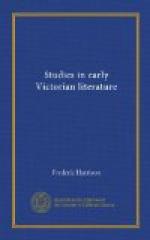Violet, asphodel, ivy, and vine-leaves,
roses and lilies—
Nereid, siren, and triton, and dolphin,
and arrowy fishes.
These lines are true hexameters, chiefly because they consist of Latin and Greek words; and they have little more than forty letters, of which barely more than half are consonants. They would be almost pure hexameters, if in lieu of the long a[a-macron]nd, we could put e[e-breve]t, or te [tau epsilon]. And there are only three Saxon words in the two lines. But hexameters consisting of purely English words, especially of Anglo-Saxon words, halt and stammer like a schoolboy’s exercise. The attempt of Kingsley in Andromeda is most ingenious and most instructive.
I have dwelt so much upon Kingsley’s poetry because, though he was hardly a “minor poet,”—an order which now boasts sixty members—he wrote a few short pieces which came wonderfully near being a great success. And again, it is the imaginative element in all his work, the creative fire and the vivid life which he threw into his prose as much as his verse, into his controversies as much as into his fictions, that gave them their popularity and their savour. Nearly every one of Kingsley’s imaginative works was polemical, full of controversy, theological, political, social, and racial; and this alone prevented them from being great works. Interesting works they are; full of vigour, beauty, and ardent conception; and it is wonderful that so much art and fancy could be thrown into what is in substance polemical pamphleteering.
Of them all Hypatia is the best known and the best conceived. Hypatia was written in 1853 in the prime of his manhood and was on the face of it a controversial work. Its sub-title was—New Foes with an Old Face,—its preface elaborates the moral and spiritual ideas that it teaches, the very titles of the chapters bear biblical phrases and classical moralising as their style. I should be sorry to guarantee the accuracy of the local colouring and the detail of its elaborate history; but the life, realism, and pictorial brilliancy of the scenes give it a power which is rare indeed in an historical novel. It has not the great and full knowledge of Romola, much less the consummate style and setting of Esmond; but it has a vividness, a rapidity, a definiteness which completely enthral the imagination and stamp its scenes on the memory. It is that rare thing, an historical romance which does not drag. It is not one of those romances of which we fail to understand the incidents, and often forget what it is that the personages are struggling so fiercely to obtain. No one who has read Hypatia in early life will fail to remember its chief scenes or its leading characters, if he lives to old age. After forty years this romance has been cast into a drama and placed upon the London stage, and it is frequently the subject of some vigorous pictures.




